 |
 |
 |
 |
 |
 |
 |
 |
 |
 |
 |
 |
 |
 |
 |
 |
 |
 |
 |
 |
 |
 |
 |
 |
 |
 |
 |
 |
 |
 |
 |
 |
 |
 |
 |
 |
 |
 |
 |
 |
 |
 |
 |
 |
 |
 |
 |
 |
 |
 |
 |
 |
 |
 |
 |
 |
 |
 |
 |
 |
 |
 |
 |
 |
 |
 |
 |
 |
 |
 |
 |
 |
 |
 |
 |
 |
 |
 |
 |
 |
 |
 |
 |
 |
 |
 |
 |
 |
 |
 |
 |
 |
 |
 |
 |
 |
 |
 |
 |
 |
 |
 |
 |
 |
 |
|
|
Breeding Spotted Donkeys |
|
|
|
 |
|
|
|
 |
|
|
|
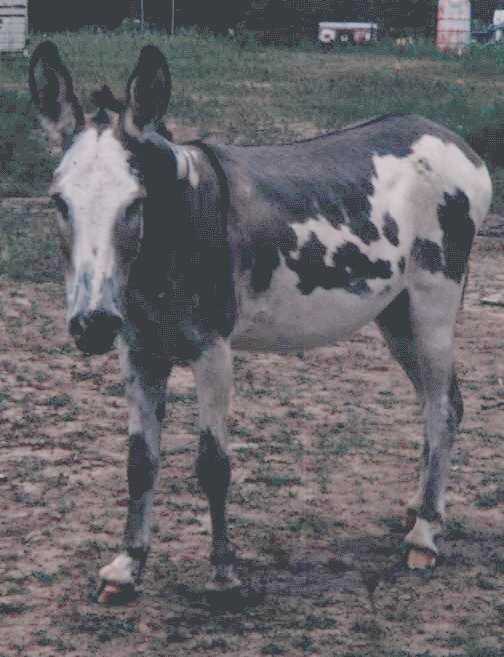 |
|
|
All research so far points to the Spotted Ass gene in donkeys as being a Partial Dominant. This means only one dose of the spotted gene is needed to produce a spotted offspring. (It also means that one parent must be spotted in order for a foal to be spotted). It doesn't matter if a solid-colored (non-spotted) donkey has spotted parents. Once a dominant gene is no longer expressed, it doesn't matter how many times it appears in the background.
Please remember that ADMS counts Masked Spotted (blaze-faced) donkeys as genetically spotted. The VISUAL requirements for a donkey to be registered as Spotted must be a contrasting body spot above the knees or hocks, or on the the neck below the throatlatch. Just a blaze and a white hoof are not enough for the COLOR REGISTRY requirements, but we do recognize that it is fully capable of the GENETIC requirements of a spotted animal. |
|
|
|
|
|
|
|
|
|
Breeding for color should be, of course, only done if you have animals with excellent conformation as well. Color is the icing, NOT the cake. |
|
|
|
|
|
|
Crystamarq Mario, a Slate Gray and white Spotted Large Standard Gelding, owned by Colleen Moore |
|
|
|
|
|
Why aren't donkeys called Paints?
Paint is a breed of horse, defined by specific breed type, and coloration. A Paint horse must have Paint, TB, or Quarter Horse parentage, and should have the contrasting Paint (pinto) markings. Horses who are Pinto-marked but who do not have the Stock breed bloodlines are not Paints.
Donkeys and mules MIGHT be able to be listed as Pintos, but they do not meet the bloodline requirements for Paints. The color registry for Spotted donkeys is the American Council of Spotted Asses. The correct term for a pinto-marked donkey is Spotted. (There are also no true Appaloosa spotted donkeys, so the color term does not need further breakdown).
So how do I get these Spotted Asses? Won't I get more spotted foals if both parents are spotted? |
|
|
|
Every animal has PAIRS of genes. One half of the pair came from the sire (father), the other half from the mother. Genes link up in long strings, and the colors are made up of groupings of color genes that work together. When you get two genes that are the SAME, they are HOMOZYGOUS. When two genes in a pair are different from each other, they are HETEROZYGOUS.
Breaking color down into the VERY BASICS (there really is a lot more at work that this) you have genes for A) Base Color (red or black) B. Base modifiers C)Spotted or non-spotted DRoan or non-roan, E) Ivory or non-ivory. THere are many more than this, but these are the basics that most donkey breeders will be concerned with.
For the layout of Spotted probability, we'll ignore all the other possible factors at first. We'll show you (yes, it gets more complicated as you add them back in) how other genes can influence this later.
THE BASICS |
|
|
|
Spotting in donkeys so far appears to be a simple Partial Dominant. We have no record yet of a HOMOZYGOUS (carrying 2 doses of spots) donkey. This means that spotted donkeys have one gene for spotted, one gene for non-spotted in that particular gene pair. We'll use S for spotted and s for non-spotted (or solid). |
|
|
|
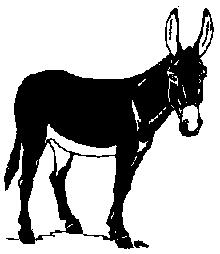 |
|
|
|
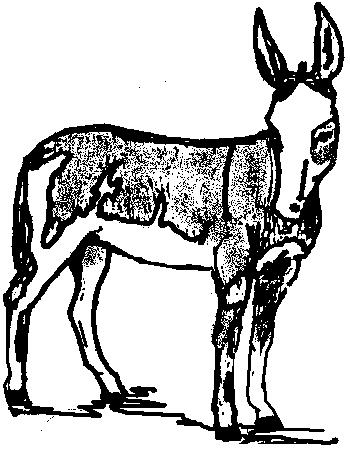 |
|
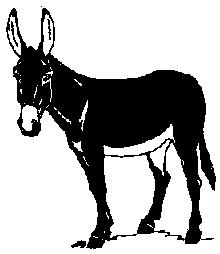 |
|
|
|
|
 |
|
|
|
|
|
|
|
|
|
|
|
|
|
Gene 1 Gene 2 |
|
|
|
Gene A Gene B |
|
|
|
|
|
Solid colored (non-spotted) jennet. (ss) Whether or not her parents or grandparents were spotted doesn't matter she is ss (non-spot/non-spot) in makeup. |
|
|
Spotted Jack. He has one gene for Spot, one for non-spotted. (Ss) At least one of his parents was spotted. |
|
|
|
|
Remembering back to high-school genetics, you have 4 combinations of basic gene pairing. |
|
|
|
 |
|
|
|
 |
|
|
|
|
 |
|
|
|
 |
|
|
|
|
|
|
|
|
 |
|
|
|
|
|
|
|
 |
|
 |
|
 |
|
|
|
|
|
|
|
|
|
|
|
|
|
|
|
|
|
|
|
|
|
|
|
|
Foal 2 (1B) |
|
Foal 4 (2B) |
|
|
Foal 1 (1A) |
|
|
Foal 3 (2A) |
|
|
|
|
|
|
|
This foal is solid colored. (ss) It got the non-spotted gene from both parents. It will never be able to pass along a spotted gene to it's offspring.
You could breed it to a spotted animal and get spotted foals, but the spot won't have come from this side! There is no spotted gene in this animal to pass along. |
|
|
|
This foal is also solid colored. (ss)
You have a 50/50 chance of getting solid foals using a spotted animal crossed to a solid animal. |
|
|
|
|
This foal is spotted. (Ss) It has the spotted gene inherited from the sire. Exactly as above, it has a 50/50 chance of passing along it's own spotted gene to future offspring. |
|
|
|
|
|
Spotted foal. (Ss) It has the spot gene from the sire, the solid from the mother. Statistically, half of it's offspring will inherit the spotted gene. |
|
|
|
|
|
|
|
|
|
|
|
|
Okay, so do I have a better chance breeding spot to spot? |
|
|
|
 |
|
 |
|
|
|
|
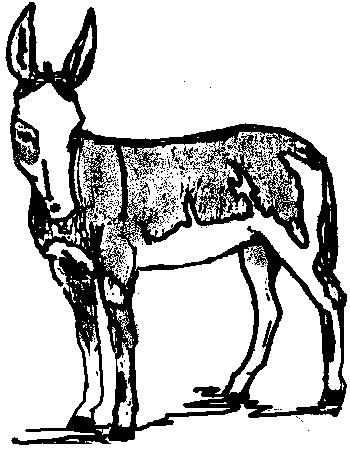 |
|
|
|
|
 |
|
|
|
|
|
|
|
|
|
|
|
|
|
Gene 1 Gene 2 |
|
|
|
Gene A Gene B |
|
|
|
|
|
Spotted Jack (Ss) |
|
|
|
Spotted jennet (Ss) |
|
|
|
|
|
 |
|
 |
|
|
|
|
 |
|
|
|
 |
|
|
|
|
|
 |
|
 |
|
|
 |
|
|
|
|
|
|
|
 |
|
|
|
|
|
|
|
|
|
|
|
|
|
|
|
|
|
|
|
|
|
|
|
|
|
|
Foal 3 (2A) Foal 4 (2B) |
|
|
Foal 1 (1A) Foal 2 (1B) |
|
|
|
|
|
|
(ss). Again, a solid colored foal. No spots, no spotted gene to pass along to future offspring. |
|
|
|
(SS). The Hypothetical HOMOZYGOUS spotted donkey. We have no records to support a true homozygout. Instead, as in some strains of Overo Paint horse, it looks as if this could be a possible lethal. If you lay out the statistics of Spot x spot matings, you should see 25% solid, 75% spotted. Instead we see 33% solid, 66% spotted. This is a fairly reliable indicator that the fourth combination shown here is a lethal gene. |
|
|
|
(Ss). A spotted foal. This particular animal got the solid gene from sire, spotted from dam (although it seems to make to difference). It will be able to pass the spotted gene to its offspring 50% of the time (statistically*). |
|
(Ss). Also a spotted foal. It has the ability to pass along the spot gene 50% of the time (although as anyone who has ever flipped a quarter knows, it doesn't work out heads/tails/heads/tails each time). |
|
|
|
|
|
|
|
|
|
So what is lethal white, and what happens to the foal? In Paint horses, pure white (lethal white) foals are born, usually alive, but die very shortly after birth from incomplete intestinal tracts.
In donkeys, we have had one or two reports of stillborn or newborn deaths of solid white foals from spot x spot matings. HOWEVER the MOST IMPORTANT thing to determine if these were true Lethal WHITES was not done - a Post Mortem. Until we have verified PMs on White donkey foals, we will NOT know if a true lethal exists. If you have bed spot x spot and LOSE A WHITE FOAL - take it to your vet IMMEDIATELY and please contact ADMS.
Otherwise - your jennet may absorb or abort the foal. This may be done almost immediately and you might never even realize she missed a heat cycle, or you may just know she lost a foal. Either way, any records you can keep will help the future of Spotted donkeys. |
|
|
|
|
|
|
Equine Basics Lingo
Miniature Donkeys Standard Donkeys
Mammoth Jackstock
Longeared Hybrids - Mules and Hinnies
FAQ about Showing and Registration
FAQ about Color COLOR Definitions
Spotted Asses Breeding for Spots
Photos. Mule Coloration
the ADMS Zebrass?
Links Hee Haw Books
Fun Transporting
Tail-less donkeys? |
|
|
HOME FAQ about Color |
|
|
|
|










